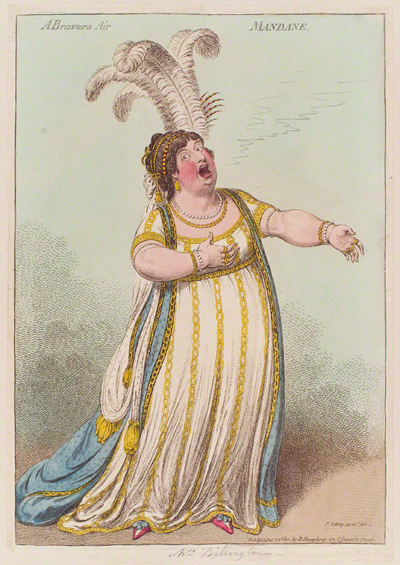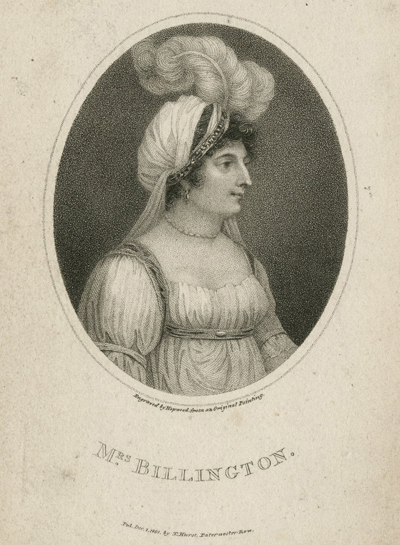A Bravura Air. Mandane
This print shows Mrs. Elizabeth Billington in the role of Xerxes daughter, Mandane in the three act opera Artaxerxes by Thomas Arne. She is probably singing the aria, "The Soldier, Tir'd of War's Alarms" in Act 3, which requires a bravura performance such as only a soprano with a large range and consummate technical skills can handle. By all accounts, Mrs. Billington was famous for such performances.

© National Portrait Gallery, London
Elizabeth Billington came from a distinguished musical family. Her father, Carl Weichsel, was the principal clarinetist or oboist at the King's Theater. Her mother, was a star in her own right, a principal singer at the Oratorios and concerts given by Bach and Abel, and for many years a favorite performer in London. Among print and painting enthusiasts, she is perhaps best known as the singer featured in Thomas Rowlandson's most famous watercolor and print, Vauxhall Gardens (1784, 1785).
Following in her parents footsteps, Elizabeth began performing as a pianist when still a child, and at fourteen took up singing. Before she was twenty, she was already appearing in a wide range of operatic roles, and made her London debut in February 1786. After successful command performances at Covent Garden, she accepted an offer to complete the remainder of the season for an almost unheard of sum of a thousand pounds.
By 1801 when this print appeared, Mrs Billington was one of the most famous and sought after opera stars not only in England but also in Europe. She had returned to England after eight triumphant years abroad in Italy, and such was her fame that both major theaters—Covent Garden and Drury Lane— competed to sign her to lucrative contracts. In what was probably a first in theatrical history, she signed with both, alternating appearances at the rival venues. Mandane was the part she chose to play for her 1801 debut. Along with appearances at other venues, she is estimated to have made 10,000 - 15,000 pounds that year.
It is not clear that Gillray ever witnessed a performance of Mrs. Billington. If he had, one would think that he would have produced a more distinct and memorable caricature. As it is, the portrait has Gillray's usual compositional integrity with the curve of Mrs. Billington's body echoed in the curve of her plume and her outstretched fingers echoed in the five jutting quills (?) above her head. But though finely finished, it is, unfortunately, not much more than a caricature of a fat lady singing.
Some of the details in her headdress, ear rings, and jewels suggest that he may have seen the stipple portrait of Mrs. Billington engraved by James Hopwood which had been published several weeks earlier on December 1st, 1801.

© Folger Shakespeare Library
Sources and Reading
- Commentary from the British Museum on A Bravura Air. Mandane
- "Mrs. Elizabeth Billington," A Dictionary of Music and Musicians:Wikisource
- "Memoir of Mrs. Billington," The Harmonicon, Volume 8
- "Elizabeth Billington," Yodelout!Music
- "What a Nineteenth-Century English Soprano Can Teach Us About the Income Gap," Penguin Press
- Thomas Wright and R.H. Evans, Historical and Descriptive Account of the Caricatures of James Gillray #508
Comments & Corrections
NOTE: Comments and/or corrections are always appreciated. To make that easier, I have included a form below that you can use. I promise never to share any of the info provided without your express permission.